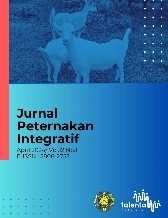Carcass Quality of 75 Days Kampung Unggul Balitnak Chickens Fed Diets With Fermented Cassava Leaf Flour (Manihot Utilissima)
DOI:
https://doi.org/10.32734/jpi.v12i2.17535Keywords:
Carcass Weight, Carcass Percentage, Fermented Cassava Leaf, Native Chickens, Slaughter WeightAbstract
The advantage of Kampung Unggul Balitnak Chickens chicken is that the harvest period is shorter than ordinary native chicken. This study aims to determine the effect of fermented cassava leaf flour (Manihot Utilissima) in commercial fed on the quality of carcasses of Kampung Unggul Balitnak chickens aged 75 days. The research method used was a complete randomized design (CRD) with 4 treatments consisting of P0 = 100% commercial ration + 0% fermented cassava leaf flour, P1 = 98% commercial ration + 2% fermented cassava leaf flour, P2 = 96% commercial ration + 4% fermented cassava leaf flour, P3 = 94% commercial ration + 6% fermented cassava leaf flour with 5 replicates. Parameters observed included slaughter weight, carcass weight and carcass percentage. The data obtained were analyzed using Analysis of Variance (ANOVA). The results showed that the provision of fermented cassava (Manihot Utilissima) leaf meal in commercial rations on 75-day-old KUB chickens had no significant effect (P>0.05) on slaughter weight, carcass weight and carcass percentage. In conclusion addition of fermented cassava flour in commercial fed did not effect carcass quality thus 6% of fermented cassava flour could be used as an additional ingredients in commercial rations.
Downloads
Downloads
Published
Issue
Section
License
Copyright (c) 2024 Jurnal Peternakan Integratif

This work is licensed under a Creative Commons Attribution-ShareAlike 4.0 International License.
The Authors submitting a manuscript do so on the understanding that if accepted for publication, copyright of the article shall be assigned to Jurnal Peternakan Integratif as well as TALENTA Publisher Universitas Sumatera Utara as the publisher of the journal.
Copyright encompasses exclusive rights to reproduce and deliver the article in all forms and media. The reproduction of any part of this journal, its storage in databases and its transmission by any form or media, will be allowed only with written permission from Jurnal Peternakan Integratif.
The Copyright Transfer Form can be downloaded here.
The copyright form should be signed originally and sent to the Editorial Office in the form of original mail or scanned document.















